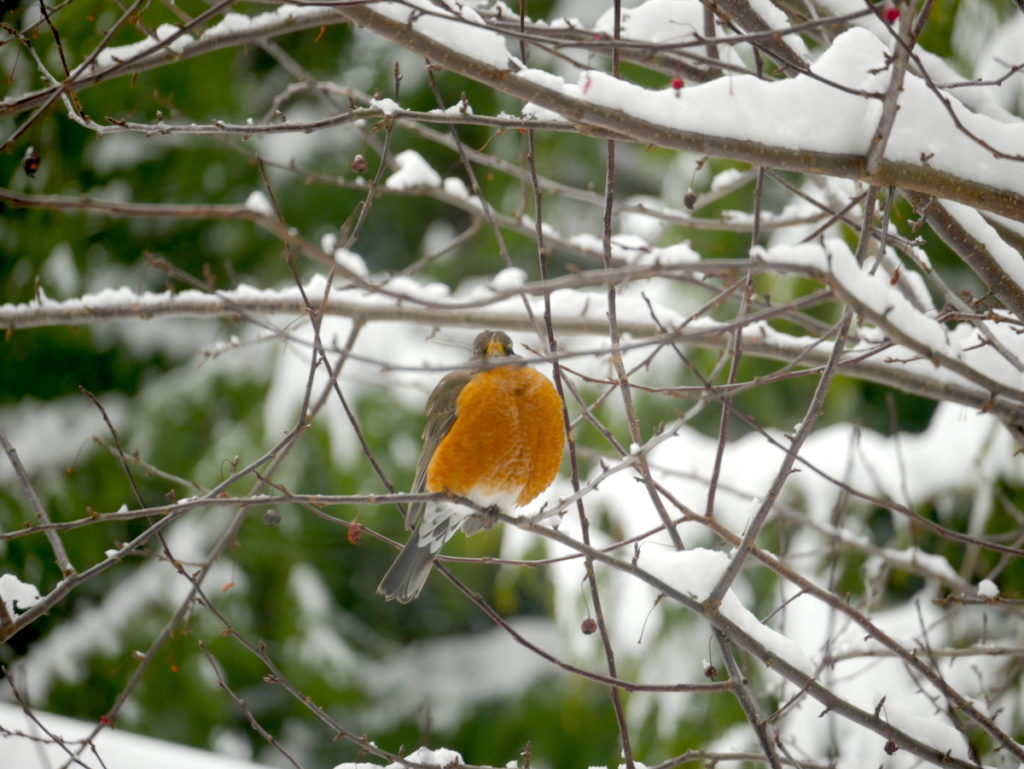
American robin uses ptiloerection (fluffed-up feathers) to stay warm | SJPT staff photo
Bitter cold, howling winds, snow and ice: These are the teeth of winter! In the islands, episodes of intense weather are typically short-lived. While likely to cause inconvenience and even some frozen pipes, our occasional arctic conditions are—for people fortunate enough to live in cozy shelters—more confining than life-threatening. If we have taken steps to prepare, winter storms can be fascinating to observe. The recent one got us thinking about some of the strategies local wildlife employs to cope with the worst of winter.
❄️Hibernation: An extreme state of dormancy with extended periods of reduced metabolism to save energy, hibernation is utilized by some local warm-blooded animals such as short-eared bats, deer mice and bumble bee queens.
❄️Brumation: The same as hibernation but for cold-blooded animals such as frogs, toads, snakes, long-toed salamanders, and alligator lizards. A sheltered place where they hunker down to wait out winter is called a hibernaculum (see an example in this video).
❄️Torpor: Hummingbirds that do not migrate, like our Anna’s, can enter a modified hibernation, called torpor, when necessary. They regulate their heart rate and body temperature for varying periods of time, going into a sort of “standby mode” to conserve energy.
❄️Controlled circulation: Birds can conserve heat loss and protect themselves from freezing by regulating blood flow to their extremities via an amazing mechanism called “thermo regulation.” They also utilize “tucking”—pulling feet, legs, and heads under their feathers.
❄️Sheltering: Animals in the wild are experts at finding protection from storms. They bed down in dense shrub thickets and forests, nestle under the snow, hide inside hollow logs and rock crevices, and take refuge in dens and nests to wait out extreme conditions.
❄️Winter insulation: Some birds, such as geese and grouse, grow a special layer of winter plumage that adds insulation. Fluffing out feathers (aka ptiloerection) is another strategy for trapping warm air next to the skin. Fox, deer, mink, otter and beaver increase the density of their fur during autumn to ensure winter warmth. The winter coats of deer are darker to absorb more heat and have a layer of longer, hollow guard hairs in addition to an undercoat.
❄️Winter Nests: Squirrels will often use a special winter nest that is protected from harsh weather and closer to food caches than the nest use in spring and summer for raising young.
❄️Huddling: Many birds and rodents huddle together during winter cold spells. Beaver have been known to let muskrats snuggle into their dens during the cold – taking advantage of the heat generated by more warm bodies – and small birds cluster for the same benefit when temperatures plummet
❄️Storing fat: For our over-wintering wildlife, survival is strongly linked to physical condition at the onset of the long, cold, wet season. Building up body fat stores in the fall is essential, and each species up for stocks up for lean times in their own way. For some, like deer and raccoons, this means adding layers of body fat, for others, like beaver and muskrat, extra fat is stored in their tails.
With so many strategies, adaptations, and mechanisms to ensure survival, the creatures around us have evolved to survive and flourish. To do so, however, they need healthy, intact natural systems to support their needs for breeding, nesting, nourishment, shelter, and safety—which is where our land conservation and ecosystem restoration work comes in.
We can’t know what challenges winter may bring, but we take heart knowing the lands preserved and protected by the Preservation Trust are there every day of the year, offering sanctuary, sustaining life, and signaling hope, no matter what the weather.
